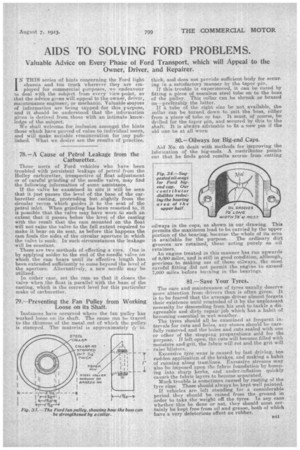AIDS TO SOLVING FORD PROBLEMS.
Page 25

If you've noticed an error in this article please click here to report it so we can fix it.
Valuable Advice on Every Phase of Ford Transport, which will Appeal to the Owner, Driver, and Repairer.
IN THIS series of hints concerning the Ford light chassis and ton truck wherever they are employed for commercial purposes, we endeavour to deal with the subject from every view-point, so that the advice given will appeal to the owner, driver, maintenance engineer, or mechanic. Valuable sources of information are being tapped for this purpose, and it should be understood that the information given is derived from those with an intimate know
ledge of the subject. .
We shall welcome for inclusion amongst the hints those which have proved of value to individual users, and will make suitable remuneration for any published. What we desire are the results of practice.
78.—A Cause of Petrol Leakage from the Carburetter.
Those users of Ford vehicles who have been troubled with persistent leakage of petrol from the Holley carburetter, irrespective of float adjustment or of careful grinding of the needle valve, may find the following information of some assistance. If the valve be examined in situ it will be seen that it just passes the level of the base of the carburetter casting, protruding but slightly from the circular recess which guides it to the seat of the petrol inlet. When grinding has been resorted to, it is possible that the valve may have worn to such an extent that it passes below the level of the casting with the result that the cam mounted on the float will not raise the valve to the full extent required to make it bear on its seat, as before this happens the cam fouls the sides of the circular aperture in which the valve is sunk. In such circumstances the leakage will be constant.
There are two methods of effecting a cure. One is by applying solder to the end of the needle valve on -which the cam bears until its effective length has been extended sufficiently to come beyond the level of the aperture. Alternatively, a new needle may be utilized.
In either case, set the cam so that it closes the valve when the float is parallel with the base of the casting, which is the correct level for this particular make of carburetter.
79.—Preventing the Fan Pulley from Working Loose on its Shaft.
Instances have occurred where the fan pulley has worked loose on its shaft. The cause can be traced to the thinness of the metal out of which the pulley. is stamped. The material is approximately 111. thick, and does not provide sufficient body for secur. ing in a satisfactory manner by the taper pin.
if this trouble is experienced, it can be cured by fitting a piece of seamless steel tube on to the boss of the pulley. This collar can be shrunk or brazed on—preferably the latter. If a tube of the right size be not available, the collar can be turned down to suit the boss, either from a piece of tube or bar. It must, of course, be• drilled for the taper pin, and secured by this to the shaft. It is always advisable to fit a new pin if the old one be at all worn
80.—Oilways for Big-end Caps.
Aid No. ea dealt with methods for improving the lubrication of the big-ends. A. contributor points out that he finds good results accrue from cutting oilwa,ys in the caps, as shown in our drawing. This permits the maximum load to be carried by the upper portion of the bearing, because the whole of its area
is available for the purpose. The ordinary dirt grooves are retained, these acting purely naoil retainers.
An engine treated in this manner has run upwards of 9,000 miles, and is still in good condition, although, previous to making use of these oilways, the most careful fitting did not permit the engine to exceed 7,000 miles before burning in the bearings.
81.—Save Your Tyres.
The care and maintenance of tyres usually deserve more attention from drivers than is often given. It is to be feared that the average driver almost forgets their existence until reminded of it by the unpleasant necessity 'for descending born his seat to tackle a disagreeable and dirty repair job which has a habit of becoming essential in wet weather.
The tyres should all be examined at frequent inter vale for cuts and holes, any atones should be carefully removed and the holes and cuts sealed with one or other of the stopping preparations sold for the purpose. If left open, the cuts will become filled with moisture and grit, the fabric will rot and the grit will raise blisters. Excessive tyre .wear is caused by fast driving, too sudden application of the brakes, and making a habit of running along tramlines. Excessive stresses may also be imposed upon the fabric foundation by bumping into sharp kerbs, and under-inflation quickly causes the fabric layers to become separated. Much trouble is sometimes caused by rusting of the tyre rims. These should always be kept well painted.. If vehicles are left standing for a considerable period they should be raised from the ground in order to take the weight off the tyres. In any,cs,se whether this be done or not, they should most certainly be kept free from oil and grease, both of which have a very deleterious effect on rubber.




























